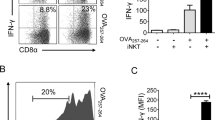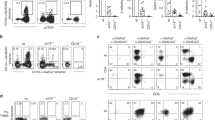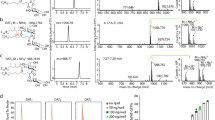Abstract
Natural killer T (NKT) cells constitute a highly conserved T lymphocyte subpopulation that has the potential to regulate many types of immune responses through the rapid secretion of cytokines1,2. NKT cells recognize glycolipids presented by CD1d, a class I-like antigen-presenting molecule. They have an invariant T-cell antigen receptor (TCR) α-chain, but whether this invariant TCR recognizes microbial antigens is still controversial. Here we show that most mouse and human NKT cells recognize glycosphingolipids from Sphingomonas, Gram-negative bacteria that do not contain lipopolysaccharide3,4,5. NKT cells are activated in vivo after exposure to these bacterial antigens or bacteria, and mice that lack NKT cells have a marked defect in the clearance of Sphingomonas from the liver. These data suggest that NKT cells are T lymphocytes that provide an innate-type immune response to certain microorganisms through recognition by their antigen receptor, and that they might be useful in providing protection from bacteria that cannot be detected by pattern recognition receptors such as Toll-like receptor 4.
This is a preview of subscription content, access via your institution
Access options
Subscribe to this journal
Receive 51 print issues and online access
$199.00 per year
only $3.90 per issue
Buy this article
- Purchase on Springer Link
- Instant access to full article PDF
Prices may be subject to local taxes which are calculated during checkout





Similar content being viewed by others

References
Taniguchi, M., Harada, M., Kojo, S., Nakayama, T. & Wakao, H. The regulatory role of Vα14 NKT cells in innate and acquired immune response. Annu. Rev. Immunol. 21, 483–513 (2003)
Brigl, M. & Brenner, M. B. CD1: antigen presentation and T cell function. Annu. Rev. Immunol. 22, 817–890 (2004)
Kawahara, K. et al. Chemical structure of glycosphingolipids isolated from Sphingomonas paucimobilis. FEBS Lett. 292, 107–110 (1991)
Kawahara, K., Moll, H., Knirel, Y. A., Seydel, U. & Zahringer, U. Structural analysis of two glycosphingolipids from the lipopolysaccharide-lacking bacterium Sphingomonas capsulata. Eur. J. Biochem. 267, 1837–1846 (2000)
Kawahara, K., Kubota, M., Sato, N., Tsuge, K. & Seto, Y. Occurrence of an alpha-galacturonosyl-ceramide in the dioxin-degrading bacterium Sphingomonas wittichii. FEMS Microbiol. Lett. 214, 289–294 (2002)
Kobayashi, E., Motoki, K., Uchida, T., Fukushima, H. & Koezuka, Y. KRN7000, a novel immunomodulator, and its antitumor activities. Oncol. Res. 7, 529–534 (1995)
Kawano, T. et al. CD1d-restricted and TCR-mediated activation of Vα14 NKT cells by glycosylceramides. Science 278, 1626–1629 (1997)
Brossay, L. et al. CD1d-mediated recognition of an α-galactosylceramide by natural killer T cells is highly conserved through mammalian evolution. J. Exp. Med. 188, 1521–1528 (1998)
Zhou, D. et al. Lysosomal glycosphingolipid recognition by NKT cells. Science 306, 1786–1789 (2004)
Neef, A., Witzenberger, R. & Kampfer, P. Detection of sphingomonads and in situ identification in activated sludge using 16S rRNA-targeted oligonucleotide probes. J. Ind. Microbiol. Biotechnol. 23, 261–267 (1999)
Sidobre, S. et al. The T cell antigen receptor expressed by Vα14i NKT cells has a unique mode of glycosphingolipid antigen recognition. Proc. Natl Acad. Sci. USA 101, 12254–12259 (2004)
Matsuda, J. L. et al. Natural killer T cells reactive to a single glycolipid exhibit a highly diverse T cell receptor β repertoire and small clone size. Proc. Natl Acad. Sci. USA 98, 12636–12641 (2001)
Wu, D. Y., Segal, N. H., Sidobre, S., Kronenberg, M. & Chapman, P. B. Cross-presentation of disialoganglioside GD3 to natural killer T cells. J. Exp. Med. 198, 173–181 (2003)
Schumann, J., Voyle, R. B., Wei, B. Y. & MacDonald, H. R. Cutting edge: influence of the TCR V β domain on the avidity of CD1d:α-galactosylceramide binding by invariant Vα14 NKT cells. J. Immunol. 170, 5815–5819 (2003)
Lehuen, A. et al. Overexpression of natural killer T cells protects Vα14- Jα281 transgenic nonobese diabetic mice against diabetes. J. Exp. Med. 188, 1831–1839 (1998)
Fujii, S., Shimizu, K., Kronenberg, M. & Steinman, R. M. Prolonged IFN-γ-producing NKT response induced with α-galactosylceramide-loaded DCs. Nature Immunol. 3, 867–874 (2002)
Brossay, L. et al. Structural requirements for galactosylceramide recognition by CD1-restricted NK T cells. J. Immunol. 161, 5124–5128 (1998)
Vincent, M. S., Gumperz, J. E. & Brenner, M. B. Understanding the function of CD1-restricted T cells. Nature Immunol. 4, 517–523 (2003)
Skold, M. & Behar, S. M. Role of CD1d-restricted NKT cells in microbial immunity. Infect. Immun. 71, 5447–5455 (2003)
Mempel, M. et al. Natural killer T cells restricted by the monomorphic MHC class 1b CD1d1 molecules behave like inflammatory cells. J. Immunol. 168, 365–371 (2002)
Brigl, M., Bry, L., Kent, S. C., Gumperz, J. E. & Brenner, M. B. Mechanism of CD1d-restricted natural killer T cell activation during microbial infection. Nature Immunol. 4, 1230–1237 (2003)
Fischer, K. et al. Mycobacterial phosphatidylinositol mannoside is a natural antigen for CD1d-restricted T cells. Proc. Natl Acad. Sci. USA 101, 10685–10690 (2004)
Amprey, J. L. et al. A subset of liver NK T cells is activated during Leishmania donovani infection by CD1d-bound lipophosphoglycan. J. Exp. Med. 200, 895–904 (2004)
Park, S. H., Benlagha, K., Lee, D., Balish, E. & Bendelac, A. Unaltered phenotype, tissue distribution and function of Vα14+ NKT cells in germ-free mice. Eur. J. Immunol. 30, 620–625 (2000)
Gonzalez-Aseguinolaza, G. et al. Natural killer T cell ligand α-galactosylceramide enhances protective immunity induced by malaria vaccines. J. Exp. Med. 195, 617–624 (2002)
Fujii, S., Shimizu, K., Smith, C., Bonifaz, L. & Steinman, R. M. Activation of natural killer T cells by α-galactosylceramide rapidly induces the full maturation of dendritic cells in vivo and thereby acts as an adjuvant for combined CD4 and CD8 T cell immunity to a coadministered protein. J. Exp. Med. 198, 267–279 (2003)
Cheroutre, H. Starting at the beginning: new perspectives on the biology of mucosal T cells. Annu. Rev. Immunol. 22, 217–246 (2004)
Shaw, P. X., Goodyear, C. S., Chang, M. K., Witztum, J. L. & Silverman, G. J. The autoreactivity of anti-phosphorylcholine antibodies for atherosclerosis-associated neo-antigens and apoptotic cells. J. Immunol. 170, 6151–6157 (2003)
Matsuda, J. L. et al. Tracking the response of natural killer T cells to a glycolipid antigen using CD1d tetramers. J. Exp. Med. 192, 741–754 (2000)
Matsuda, J. L. et al. Mouse Vα14i natural killer T cells are resistant to cytokine polarization in vivo. Proc. Natl Acad. Sci. USA 100, 8395–8400 (2003)
Acknowledgements
We thank K. J. L. Hammond for critical reading of the manuscript, and S. Sidobre, L. Sidobre, K. J. L. Hammond and A. Khurana for mCD1d protein. This work was supported by grants from the National Institutes of Health (to M.K., to C-H.W. and to M.T.). Y.K. was supported in part by the Yamada Science Foundation.
Author information
Authors and Affiliations
Corresponding author
Ethics declarations
Competing interests
The authors declare that they have no competing financial interests.
Supplementary information
Supplementary Figure S1
This figure shows in vivo activation of V□14i NKT cells after injection of DCs pulsed with GSL-1'sA or S. yanoikuyae. (PDF 39 kb)
Supplementary Figure S2
This figure shows GSL-1'sA does not cause TNF-α production by DCs. (PDF 28 kb)
Supplementary Figure S3
This figure shows TLR4 independent activation of Vα14i NKT cells. (PDF 30 kb)
Supplementary Figure S4
This figure shows TLR independent IFN-γ production by Vα14i NKT cells. (PDF 42 kb)
Supplementary Figure S5
This figure shows IL-12 independent IFN-γ production by Vα14i NKT cells. (PDF 47 kb)
Supplementary Figure S6
This figure shows IL-12 independent IL-4 production by Vα14i NKT cells. (PDF 35 kb)
Rights and permissions
About this article
Cite this article
Kinjo, Y., Wu, D., Kim, G. et al. Recognition of bacterial glycosphingolipids by natural killer T cells. Nature 434, 520–525 (2005). https://doi.org/10.1038/nature03407
Received:
Accepted:
Issue Date:
DOI: https://doi.org/10.1038/nature03407
This article is cited by
-
CD1-mediated immune responses in mucosal tissues: molecular mechanisms underlying lipid antigen presentation system
Experimental & Molecular Medicine (2023)
-
Tnpo3 controls splicing of the pre-mRNA encoding the canonical TCR α chain of iNKT cells
Nature Communications (2023)
-
Same yet different — how lymph node heterogeneity affects immune responses
Nature Reviews Immunology (2023)
-
Intratumor microbiota: a novel tumor component
Journal of Cancer Research and Clinical Oncology (2023)
-
Therapeutic and immunomodulatory role of probiotics in breast cancer: A mechanistic review
Archives of Microbiology (2023)
Comments
By submitting a comment you agree to abide by our Terms and Community Guidelines. If you find something abusive or that does not comply with our terms or guidelines please flag it as inappropriate.


